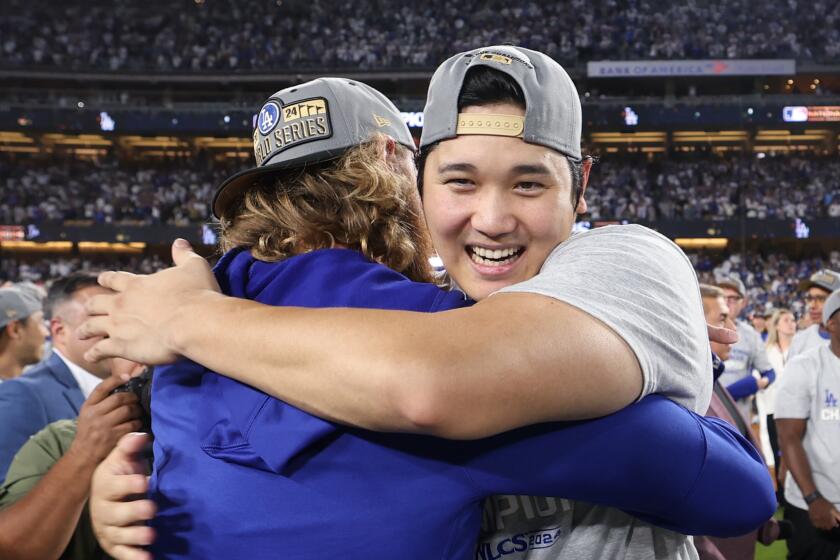
- Share via
MANZANAR, Calif. — As millions cheered Shohei Ohtani’s debut in the World Series at Dodger Stadium, a couple of dozen ballplayers of Japanese descent gathered last weekend on a dusty field 200 miles north.
A small crowd of friends and family watched as amateur teams from Los Angeles and Lodi trotted onto a recently reconstructed diamond to commemorate a time when every single one of them would have been caged behind barbed wire.
The field was at Manzanar, one of 10 camps where more than 120,000 Japanese Americans — the vast majority U.S. citizens born and raised in this country — were imprisoned during World War II.

“Manzanar is a monument to failure,” said Dan Kwong, 69, who helped restore the field, organized the game and played first base for his team, the Li’l Tokio Giants. His mother and her family had been incarcerated at the camp, he said, and “today, we’re trying to respond to the failure by educating people.”
The Manzanar National Historic Site is easy to miss while speeding along U.S. 395 in remote, eastern California. It’s tucked away in the high desert just north of Lone Pine, on the back side of the Sierra Nevada mountain range. Mt. Williamson, California’s second-highest summit, towers behind it and draws the eye skyward.
On the ground, amid the sagebrush and tumbleweeds, are a few old barracks, a weathered wooden fence strung with barbed wire and a wind-battered guard tower. The tiny parking lot is almost never full.

It’s the sort of place that’s easy to miss and most people wish never existed. Many who were imprisoned there, and at similar camps scattered in out-of-the-way corners of the country, spent the rest of their lives trying to erase the memory.
Mike Furutani, 56, a powerfully built former U.S. Marine and pitcher for the Lodi team, said his uncles were incarcerated at the Heart Mountain Camp in Wyoming. “They never talked about it,” he said over the slap of balls striking leather as players warmed up around him Saturday morning. “I believe it was something they wanted to forget.”
Shohei Ohtani suggested the Dodgers pay him only $2 million a year and defer the remainder of his annual $70-million salary. It was basically a blank check to fortify the roster.
Furutani said he didn’t even know there had been internment camps until he went to college. “Back in the day, they didn’t teach this in high school.”
After he learned about the camps, and that his uncles had been in one, Furutani said he wanted to hear their stories. But since they’d remained stoically silent on the topic for decades, he figured it probably wasn’t a good idea to ask.

“There’s a certain amount of shame about being put in a prison camp,” Furutani said. “Plus, the old Japanese male thing about internalizing everything and never showing emotion.”
Yuri Kosaka, 27, sat behind the Lodi bench. Her husband was in left field; her brother-in-law was also on the team. She was born and raised in Tokyo and had no idea Japanese American civilians had been imprisoned during the war until she came to the U.S. for college and met her husband’s family.
One of his great-aunts was born in a camp, Kosaka said. As an elderly woman, she told a few stories about life behind the barbed wire, but she was so young when she was imprisoned there that her tales were brief and short on detail, based on other people’s memories.
“It was such a hard thing to talk about, so it’s hard to keep the story alive,” Kosaka said.
“It’s easier to speak about baseball,” she said, gesturing to the field, “so this might be one way to tell the history.”

Asked if she thought mass incarceration based on ethnicity could happen again in America, Kosaka did not hesitate: “Absolutely, yes. When people stop caring about each other, yeah, I think it could happen in the future.”
Fear and suspicion are, of course, common by-products of war. After the Japanese navy launched its attack on Pearl Harbor in December 1941, a tsunami of racist propaganda washed across the United States.
Some American journalists and politicians couched their desire to round up and imprison Japanese Americans in humanitarian terms: to protect them from potential mob violence.
Others, such as the Pulitzer Prize-winning conservative columnist Westbrook Pegler, skipped the niceties and went straight to accusing their fellow citizens of being enemy saboteurs.
Many of the Japanese Americans in the U.S. at the time lived in the Golden State.
“The Japanese in California should be under armed guard to the last man and woman right now and to hell with habeas corpus until the danger is over,” Pegler wrote.
In February 1942, President Franklin Delano Roosevelt signed the executive order that officials used to pull Japanese Americans from their homes, force them to sell their property, often at a significant loss, and imprison them in the camps for years without formal charges or trials.

Baseball, the most American of sports, served as a desperately needed diversion. Some camps had up to 30 teams. As the war dragged on, they were sometimes allowed to travel from one camp to another and play against one another.
Last year, when Dan Kwong stepped onto the stretch of desert that had been the site of a baseball diamond at Manzanar, it was a “solid ocean of tumbleweeds,” he said. Clearing it by hand was “an amazing, miserable job.”
After Shohei Ohtani left Game 2 of the World Series with a partially dislocated left shoulder, the team is optimistic that he’ll be back in the lineup for Game 3 on Monday.
Most of the labor fell to him; Dave Goto, a staff arborist for the National Park Service; and a retired construction manager named Chris Siddens from the nearby town of Independence, Kwong said.
It was slow, painstaking work. They’d make some progress and then come back later only to find the weeds had sprouted again. There was concrete to pour. There was a backstop to build. There was a chicken wire fence to string.
But if it helps bring attention to this too easily forgotten chapter of American history, Kwong said, it will have been worth it.

“I’m hoping that, through baseball, more of the country faces this,” he said, “because outside of the West Coast, this is very little known.”
And there has recently been a resurgence of politicians in America who seem perfectly willing to “incarcerate people and put them away based on some identity, a religion, a faith, a culture,” Kwong said. “So you could say there are a lot of people who still have not learned from this mistake.”
Kwong hoped the “resonance” between his sparsely attended amateur game in the desert and what was happening at Dodger Stadium would help get the message out.
Eighty years ago, someone named Shohei Ohtani could never have taken center stage in the World Series. He would have been “hated, feared” and forced to play behind barbed wire, Kwong said.
“Today, he’s worshiped and admired,” Kwong said with a chuckle. That’s a great thing, and genuine progress from 1944, he said. “But I don’t pretend that racism is gone because the best player in the world is Japanese.”
More to Read
Sign up for Essential California
The most important California stories and recommendations in your inbox every morning.
You may occasionally receive promotional content from the Los Angeles Times.













